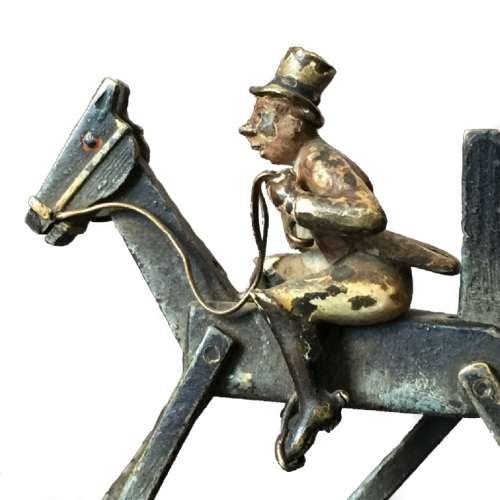- Creator - Artist - Designer: Attribué à Franz Xaver Bergmann (1861-1936)
- Edition - Fabrique: Bronze de Vienne
- Period: Fin XIXème siècle / début XXème siècle
- Price: 1250€
- Pays d'Origine: Autriche
- Dimensions (L x l x h): 5-8cm x 2cm x 5,5 cm
- Weight: 39 gr
- Condition: Bon état d'origine
- Material: Bronze
-
Price:SOLD
- Free international delivery
Articulated polychrome Vienna bronze (or mechanism) representing a mounted jockey on horse
In original condition, original patina, circa 1900.
Exceptionally rare unrestored item.
Attributed to Franz Xaver Bergman.
Biography:
Franz Bergmann (1861–1936) was the owner of a Viennese foundry which produced numerous miniature sculptures depicting oriental, erotic and animal figures in patina and in bronze, the latter often being fanciful, humorous humanized works of art.
His father came to Vienna and founded a small bronze factory in 1860. Franz Xaver Bergmann inherited the business and opened a new foundry in 1900. Many bronzes from the 1900s were still based on designs by the his father's workshop. His workshops employed, on a temporary basis, many anonymous sculptors including Bruno Zach who asked Bergmann to edit and cast some of his works, including some erotics signed "Prof. Tuch", a pseudonym used by Zach.
At the turn of the 19th century, there were around fifty similar workshops in Vienna producing 'Viennese bronzes'. “Cold painted bronze” refers to pieces cast and then decorated in several layers with so-called dust paint, usually done by women working at home.
The sensual poses of young women in the Art Nouveau or Oriental style were discreetly disguised by clothes or drapes which revealed themselves when a button was pushed or a lever moved .... Many animals such as signs musicians, hares, bears, foxes, frogs ... made the fame of these factories.
